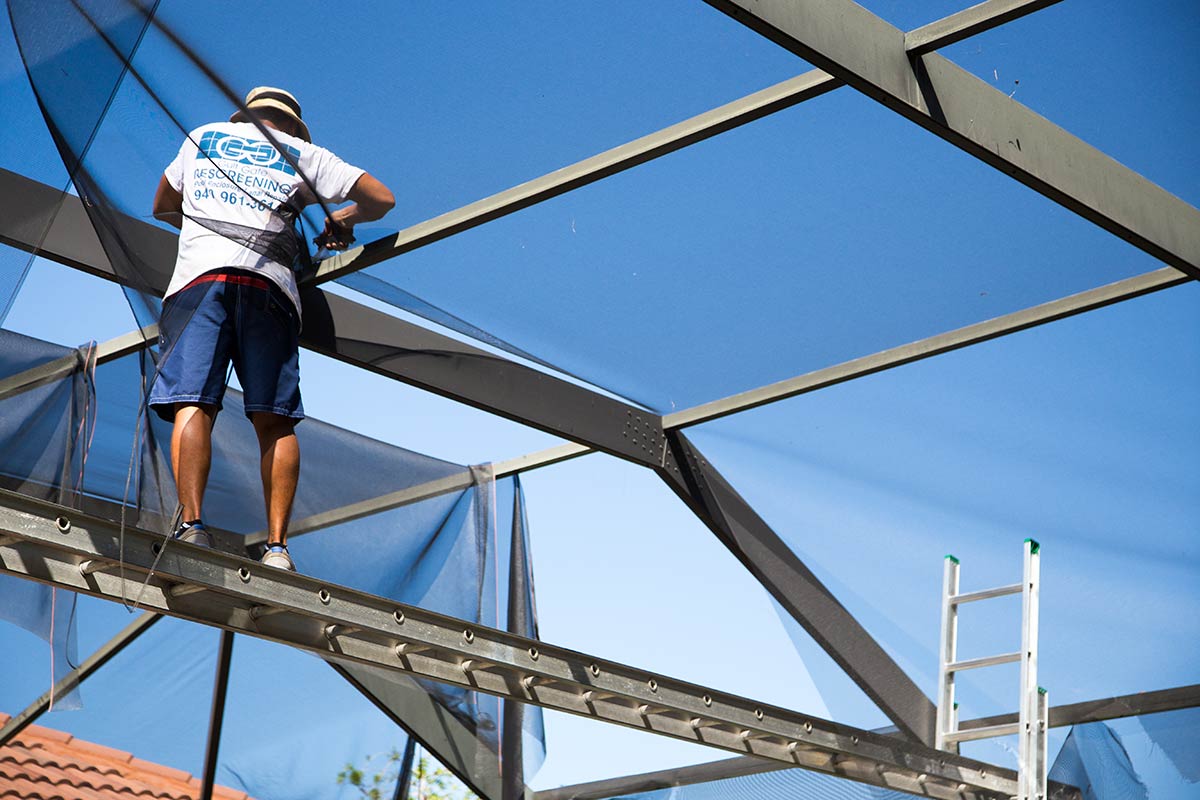If your pool cage is starting to show its age, a fresh coat of paint can make it look new again. But before you start painting, there are a few things you need to do to prepare the surface.
- The first step is to power wash the cage to remove any dirt or debris that may be clinging to it
- Once the cage is dry, you will need to scrape off any loose paint or rust that is present
- Next, apply a primer to the cage in order to prepare it for painting
- Once the primer is dry, you can begin painting the cage with your desired color of paint
- Be sure to use a paint that is specifically designed for metal surfaces
- Allow the paint to dry completely before using the pool again

Credit: sarasotaflscreenrepair.com
What are the Benefits of Painting My Pool Cage
If you are considering painting your pool cage, there are several benefits to doing so. A fresh coat of paint can help to protect the metal from corrosion and rust, as well as provide a barrier against insects and other pests. Painting your pool cage can also give it a new lease on life, breathing new life into an old structure.
In addition, painting your pool cage can add value to your home if you ever decide to sell.
How Do I Prepare the Surface for Painting
When it comes to painting, the quality of your work is only as good as the surface you’re working on. If you want a professional-looking paint job, taking the time to properly prepare your surfaces is a must. Here’s how to do it:
1. Start with a clean surface. Any dirt, dust or grease will prevent the paint from adhering properly, so make sure to give your surfaces a good cleaning before you start painting. 2. Sand smooth surfaces.
This will help create a uniform texture for the paint to adhere to. Be sure to use fine-grit sandpaper so you don’t damage the surface beneath. 3. Prime porous surfaces.
Porous materials like wood and drywall are especially susceptible to absorption, so priming them first will help ensure that your paint job looks its best. 4. Choose the right type of paint for your project.
What Type of Paint Should I Use for My Pool Cage
The type of paint you should use for your pool cage will depend on the material of the cage. If the cage is made of aluminum, you should use a high-quality acrylic paint designed for metal surfaces. If the cage is made of wood, you can use either an oil-based or latex paint.
However, if the wood is exposed to moisture, it’s best to use a latex primer followed by a topcoat of latex paint.
How Do I Apply the Paint to My Pool Cage
If you’re painting your pool cage for the first time, or if it’s been a while since you last did it, there are a few things to keep in mind. The most important thing is to use a paint that is specifically designed for metal surfaces. This will ensure that the paint adheres properly and doesn’t chip or peel over time.
Once you’ve chosen the right paint, make sure to clean the surface of the cage thoroughly before applying any paint. A wire brush can be helpful for getting rid of any rust or other build-up on the metal. Once the surface is clean, you can start painting.
It’s best to use a roller with an extension handle so you can reach all areas easily. Start by painting the top and sides of the cage, then move on to the bottom. Work in small sections so that the paint doesn’t have a chance to dry before you’re finished with that area.
Once all of the sides are painted, you can move on to any decorative details like scrolls or finials. Be sure to let each coat of paint dry completely before adding another. Depending on the type of paint you’re using, this could take anywhere from a few hours to overnight.
Best Way to Paint & Restore a Pool Cage
Conclusion
If you’re looking to spruce up your pool cage, painting it is a great way to do so. Here’s a step-by-step guide on how to paint a pool cage:
1. Start by cleaning the cage with a pressure washer or hose and scrub brush.
This will remove any dirt or grime that has built up on the surface.
2. Once the cage is clean, use painters tape to mask off any areas that you don’t want painted (such as windows or door frames).
3. Next, apply a primer to the cage using a roller or brush.
This will help the paint adhere better and provide better coverage.
4. Once the primer has dried, start painting the cage with your chosen color of paint (typically white). Use long strokes and go over each section multiple times until you’re happy with the results.